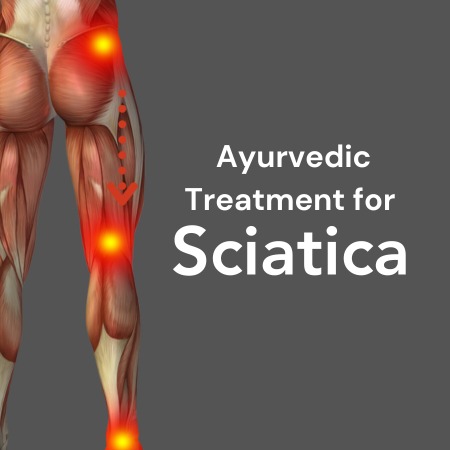Sciatica is a painful medical ailment caused by compression of the sciatic nerve, which spreads from the lower back down the hips and down the legs. Sharp, shooting pain, numbness, tingling, and muscle weakness in the affected leg are all symptoms. Typically, sciatica targets one side of the body. The pain severity ranges from mild to severe. Most patients opt to use drugs and surgery to treat this excruciating pain. The ancient school of Ayurveda provides time-tested therapies to alleviate pain and promote well-being.
As per Ayurveda, all health concerns arise due to the imbalance of doshas including Sciatica. Vata, one of the three fundamental energies associated with the air and space is responsible for movements, including the functions of the nervous system. When Vata aggravates, it can lead to neurological issues, including Sciatica. In Ayurveda, the Sciatica treatment is diagnosed by restoring the Vata balance within the body. Before proceeding with the treatment, the Ayurvedic practitioners assess the individual Prakriti and customize the suitable treatment. Because the individual responses to the treatment can vary significantly.
Causes of Sciatica:
- Degenerative Disc Disease
- Spinal Stenosis
- Herniated Disc
- Spondylolisthesis
- Piriformis Syndrome
- Trauma or Injury
- Tumors
- Muscle Spasms
Ayurvedic treatments for Sciatica:
Panchakarma Therapy: Panchakarma is a cornerstone of Ayurvedic treatment. To remove toxins (ama) from the body, a number of detoxification and rejuvenation treatments are used. Therapies including Abhyanga (warm oil massage), Swedana (herbal steam therapy), and Basti (medicated enema) are used in the context of sciatica to ease pain and inflammation, improve blood circulation, and restore the balance of Vata.
Herbal Remedies: Ayurveda uses a wide range of herbs to treat sciatic pain. Some commonly used herbs are:
- Guggulu (Commiphora wightii): This resin alleviates inflammation due to its analgesic properties.
- Shallaki (Boswellia Serrata): This anti-inflammatory herb can help alleviate sciatica discomfort.
- Erandamoola (Ricinus communis): Used to relieve pain and inflammation by external treatments and internal formulations.
Dietary Modifications:
Ayurveda emphasizes the importance of nutrition in maintaining homeostasis. Patients suffering from sciatica should follow a Vata-balancing diet that includes warm, nutritious foods while avoiding cold, dry, or processed foods. In addition, eating ginger, turmeric, and garlic can help reduce inflammation.
Yoga and Exercise:
Gentle stretching exercises and yoga postures help alleviate sciatic pain by increasing flexibility, strengthening muscles, and boosting circulation. Specific asanas for sciatica include Bhujangasana (Cobra Pose), Setu Bandhasana (Bridge Pose), and Supta Padangusthasana (Reclining Hand-to-Big-Toe Pose).
Pranayama and Meditation:
Stress aggravates Vata imbalance, so stress management is crucial in Ayurvedic sciatica treatment. Pranayama (breathing exercises) and meditation can also support calming the mind, reducing tension, and promoting relaxation, all of which can help indirectly alleviate sciatic pain.
Lifestyle Changes:
Making certain lifestyle changes to your routine can also help with healing. These include maintaining the right posture, avoiding prolonged sitting, utilizing ergonomic furniture, and getting enough sleep. Adequate sleep and rest are required for the body to restore itself.
Marma Therapy:
Marma points are key energy spots located throughout the body. Marma Therapy uses gentle massage of these areas to enhance energy flow and relieve pain. Correct treatment can provide substantial alleviation from Sciatica.
Ayurvedic practitioners may prescribe specific herbal formulations or oils for external application to reduce pain and inflammation. These formulations are tailored to the individual’s dosha and condition. Some of the commonly used formulations to alleviate inflammation are Rasna Erandadi Kashayam, Rasnasaptakam Kashayam, and Brihatri Chintamani Rasa. You can find all these formulations in Ayurcentral at affordable prices.
Ayurveda offers a comprehensive and holistic approach to treating sciatica, addressing the symptoms and underlying imbalances within the body. While Ayurvedic treatments for sciatica can be highly effective, consulting with a qualified Ayurvedic practitioner who can assess your unique constitution and design a personalized treatment plan is essential.


